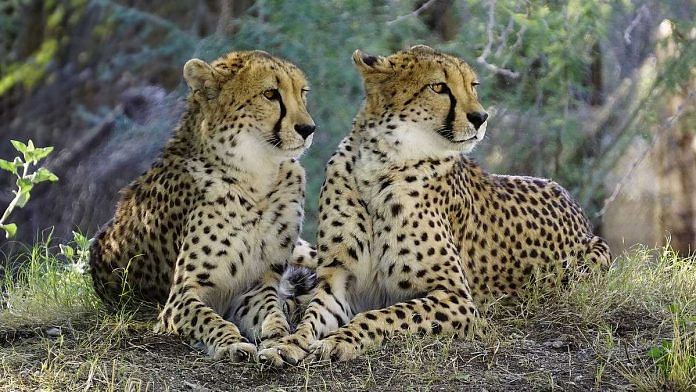New Delhi: Officials at Madhya Pradesh’s Kuno National Park have been asked to prepare for the relocation of about 12-14 cheetahs in what is going to be the world’s first intercontinental cheetah translocation project, ThePrint has learnt.
Prakash Verma, the divisional forest officer (DFO) at the Kuno National Park, told ThePrint that officials had prepared a 500-hectare enclosure for the new arrivals.
“There are three or four leopards in the area that have to be brought out before the cheetahs can move in. We are working on that now,” Verma said.
While it has been reported that the cheetahs will arrive at the park by 15 August, officials that ThePrint spoke to say that the exact date of arrival is yet to be communicated to them by the government. They added 12-14 cheetahs will arrive all at once, and that more could come over the course of time.
However, officials are worried that if the animals are brought in at this time – during peak monsoon — the process of moving them to their enclosures could be difficult.
The plan to reintroduce cheetahs — a species that went extinct in the 1950s — to India has been decades in the making. The Indian government had initially approached Iran, where the Asiatic cheetah, the same subspecies that went extinct in India, exists, and was even keen on cloning the species. When Iran refused repeatedly citing low numbers of the species in that own country, the Indian government turned to the African subspecies.
Conservationists however have been sceptical of the relocation plan, fearing that the process would detract from other conservation efforts, such as that of the Asiatic lion.
In fact, the Kuno National Park had once been the chosen site for translocation of the endangered Asiatic lion from Gir in Gujarat: In 2013 the Supreme Court had said relocation of the Asiatic lion was of “utmost importance” and ordered the Ministry of Environment and Forests to complete the process within six months of the judgment.
In 2012, the Supreme Court had stayed the government’s plans to import cheetahs — an order it upheld in 2013. At the time, the court had said that the government needed to produce a detailed study before the introduction of African cheetahs could be considered.
In 2017, the National Tiger Conservation Authority (NCTA) appealed to the Supreme Court to reconsider its decision. Three years later — in 2020 — the Supreme Court allowed cheetahs to be reintroduced on “an experimental basis” even though a court-appointed panel rejected the project.
In January this year, the central government released an ‘Action Plan For Introduction of Cheetah in India’ laying down its relocation plans.
Also Read: Unsustainable logging, hunting — new report finds what’s driving a million species to extinction
Challenging field conditions
Verma said that an expert committee from the state government had visited the park recently to review kits preparations.
“They said that talks are on between the two governments and an agreement has to be signed. We were asked to be prepared, but we have not been given an exact date,” he added.
Another park official who spoke to ThePrint on the condition of anonymity admitted that although they have been told to ensure that the process of translocating is seamless, field conditions are challenging in the monsoons.
“We’ve been asked to ensure that conditions such as floods don’t affect the fencing around the enclosures,” he told ThePrint. “Field conditions become difficult during monsoons. There are also other problems during the season, such as landslides, damaged fences or vehicles getting stuck in slush. We’re taking care to ensure these things don’t happen.”
(Edited by Uttara Ramaswamy)
Also Read: ‘To live is to kill’ — a Malabar pit viper and gliding frog affirm nature’s basic law



